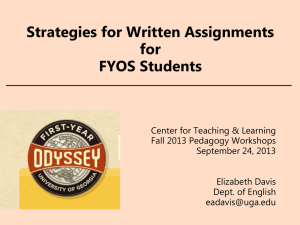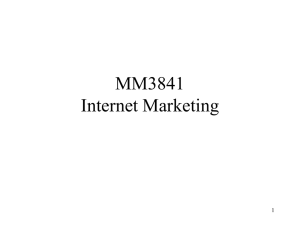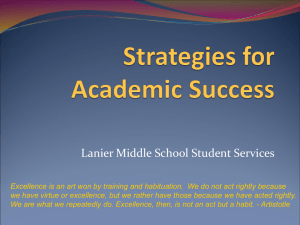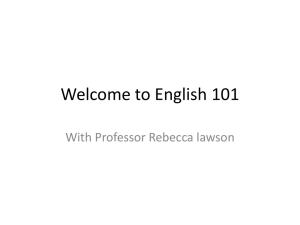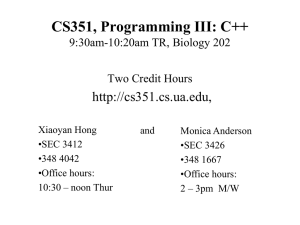MGT_303_Blended_FWE - MoserCollegeHypermediaSyllabi
advertisement
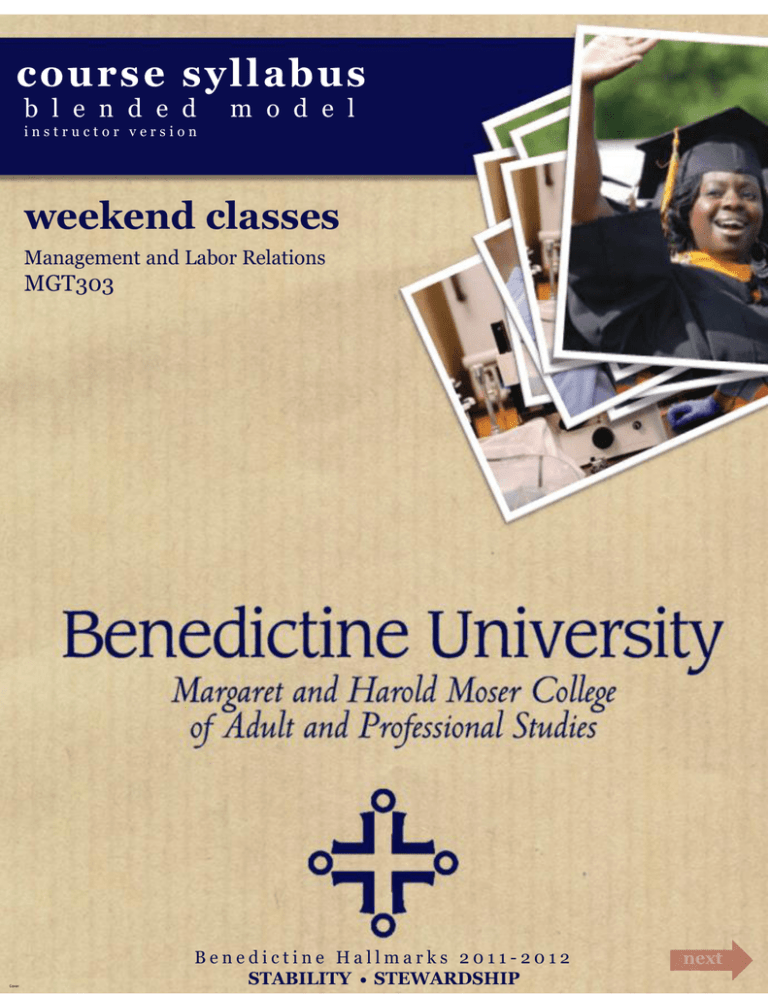
course syllabus b l e n d e d m o d e l instructor version weekend classes Management and Labor Relations MGT303 home Cover about expectations resources course overview learning outcomes Benedictine Hallmarks 2011-2012 STABILITY STEWARDSHIP IDEA schedule & sessions next course syllabus Addresses the educational needs of adult students by developing and providing engaging, relevant and accelerated programs. blended model MGT303 Enhances scholarship, leadership skills, social responsibility, and promotes life-long learning. Provides high-quality, easily accessible educational opportunities for adult learners. Management and Labor Relations instructor version Enables adults to earn specific undergraduate and graduate degrees while maintaining their personal and professional commitments. Develops new degree and non-degree programs that address the expressed needs of the professional community. content links index about this document about Moser College about blended learning hallmarks of a Benedictine education student expectations attendance policy financial aid submission of work library resources services for students with disabilities Academic Honesty Policy APA formatting and style netiquette course overview required textbooks grading scale IDEA objectives IDEA description learning outcomes course schedule Moser College Mission Statement: Moser College embodies the values of respect, excellence, collaboration, and professionalism. We are committed to delivering innovative and dynamic programs designed for adult students who are dedicated to enhancing their professional, local, and global communities. Moser College Vision Statement: To be one of the premier university colleges in the nation. Love of Christ and Neighbor Prayer Stability Conversatio Obedience Discipline Humility Stewardship Hospitality Community Benedictine University Margaret and Harold Moser Center 1832 Centre Point Circle Naperville, IL 60563 Phone: (630) 829-6289 Fax: (630) 829-1375 http://www1.ben.edu/programs/a dult_cohorts/mission_vision.asp 2 Content Links Management and Labor Relations | MGT303 About Your Program at Benedictine University – Moser College About This Document This is a hypermedia document – it has been built to mimic navigation on the web. This document can also be viewed as a presentation or it can be printed like a traditional document. We use this sort of document because it allows for navigation links (hyperlinks) to text, graphics, audio/video, and the web. This type of document also allows you to navigate in a nontraditional, nonlinear way – by following the page links you are not bound to read or flip through the document in any sort of order. This is yet another example of Moser College’s commitment to advancements in technology and blended learning. About Moser College The Moser College of Adult & Professional Studies delivers its curricular programs in a specifically designed structure deliberately oriented for working, adult learners. The Moser College is committed to providing a learning environment which extends beyond the classroom and is designed specifically to meet the needs of its students and their employers by bringing a quality educational experience without requiring the student to relocate or travel extensively beyond their home area. Benedictine University's Moser College of Adult & Professional Studies is fully accredited by the Higher Learning Commission of the North Central Association of Colleges and Schools*. * http://www.ben.edu/academic_programs/moser/about/index.cfm About Blended Learning Blended learning is the integration of different learning environments: mainly the online format with the face-to-face format, but may also include mobile learning. Blended learning, also referred to as hybrid learning, relies on both the advantages of digital/technology innovation and the methods of face-to-face instruction. At Moser College, we use blended learning by combining asynchronous online classroom sessions with a face-to-face classroom environment. hallmarks of a Benedictine Education: home about expectations resources course overview learning outcomes IDEA schedule & sessions Love of Christ and Neighbor Prayer Stability Conversatio Obedience Discipline Humility Stewardship Hospitality Community 3 About Management and Labor Relations | MGT303 The Ten Hallmarks of a Benedictine Education A Benedictine Education Based on the Rules of Saint Benedict, a Benedictine Education is based on the Benedictine Wisdom Tradition that sets as its goals the transformation of the Human mind AND Heart and has at its foundation “The Ten Hallmarks of a Benedictine Education”. The Ten Hallmarks Each academic year Moser College will be celebrating two of the Hallmarks. This academic year 2011-2012, the Hallmarks Stability and Stewardship have been chosen. The ten hallmarks are: 1. Love of Christ and Neighbor 2. Prayer: a Life marked by liturgy, lection and Mindfulness 3. Stability: commitment to the daily life of this place, its heritage and tradition 4. Conversatio: the way of formation and transformation 5. Obedience: a commitment to listening and consequent action 6. Discipline: a way toward learning and freedom 7. Humility: knowledge of self in relation to God, others and creation 8. Stewardship: responsible use of creation, culture and the arts 9. Hospitality: openness to others 10. Community: call to serve the common good home about expectations resources Portrait (1926) by Herman Nieg (1849–1928); Heiligenkreuz Abbey, Austria course overview learning outcomes IDEA schedule & sessions Love of Christ and Neighbor Prayer Stability Conversatio Obedience Discipline Humility Stewardship Hospitality Community 4 Hallmarks Management and Labor Relations | MGT303 Student Expectations Expectations of Students In order to get the maximum use of the time available, it is expected that you will: • Read the material to be covered in the class and complete required assignments prior to attending the class/session; • Arrive/login to class/session prepared to participate actively; • Be prepared to actively participate in the collaborative activities of each class/session; and • Always feel free to seek additional help from the instructor when the need arises. Attendance Policy Students may not miss more than 25% of the live classroom sessions. Doing so will result in an F for the course. financial aid information Submission of Work All assignments are to be submitted into Desire 2 Learn (D2L) unless otherwise noted by instructor. Assignments must be submitted by due date. Any assigned work submitted late for any unexcused reason will receive a lowered grade. Please refer to your instructor’s late work policy located in D2L. In the event that you miss an examination for due cause, arrangements must be made with the instructor for a make-up examination. Important criteria concerning the submission of work: • Make-up examinations may differ from the original class examination. • Per University policy, assignments cannot be accepted by an instructor after the last day of the course. • Only discussions threads posted by 11:59 pm CST on the due date will count for grading purposes. information concerning netiquette: home about expectations resources course overview learning outcomes IDEA schedule & sessions Love of Christ and Neighbor Prayer Stability Conversatio Obedience Discipline Humility Stewardship Hospitality Community 5 Expectations Management and Labor Relations | MGT303 Financial Aid Information Applying for Financial Aid A college education is one of the largest financial investments a family will make. We believe that an education from Benedictine University will provide valuable returns throughout a student's lifetime. The Office of Financial Aid is dedicated to helping students and their families make a Benedictine University education affordable. We view the process of financing an education as a partnership. Although the student and his/her family have primary responsibility for meeting college costs, Benedictine University, as well as the federal and state governments have a variety of financial aid programs available to students who need financial assistance. Types of Financial Aid Benedictine University's Office of Financial Aid administers a variety of federal, state and institutional programs of student financial assistance. All financial aid recipients must maintain satisfactory academic progress in accordance with the published, "Satisfactory Academic Progress Policy for Financial Aid Recipients.“ • After completing the financial aid application process, the student will receive a financial aid award notification letter. The award letter will include the program(s) that the student is eligible to receive and the award amount(s). • Grants/Scholarships - Grants and scholarships are considered to be gift assistance. This means the awards do not have to be repaid. • Loans - Loans are considered to be a form of self-help assistance. Loan programs provide funds for educational purposes and are paid back with interest. • Employment - Part-time jobs on campus are available to students through the University and Federal Work-Study program. Students working on campus receive a bi-weekly paycheck. • Applying for Financial Aid – All students applying for financial aid are asked to complete the Free Application for Federal Student Aid (FAFSA). FAFSA – Free Application for Federal Student Aid The FAFSA is required for all federal, state (Illinois residents) and Benedictine University need-based assistance. It should be completed as soon as possible after January 1st. Applying online with FAFSA on the Web at www.fafsa.gov is faster and easier than using a paper FAFSA. Have your completed U.S. Federal Income Tax returns readily available when completing the FAFSA. Include Benedictine University's school code: 001767 so the results of your FAFSA application will automatically be sent to our financial aid office. Sign you FAFSA with a Federal Student Aid PIN. Apply for a PIN at www.pin.ed.gov. If you are providing parent information, one parent must also sign you FAFSA. home about expectations resources course overview learning outcomes IDEA schedule & sessions Love of Christ and Neighbor Prayer Stability Conversatio Obedience Discipline Humility Stewardship Hospitality Community 6 Financial Aid Management and Labor Relations | MGT303 About Netiquette What is Netiquette? "Netiquette" stands for "Internet Etiquette", and refers to the set of practices which help to make the online experiences pleasant for all involved. As you might expect, netiquette, like other forms of etiquette, is about courtesy, manners, codes of behavior, protocols and respect. Netiquette primarily focuses on how we interact with one another online, by being aware of: our use of language, others’ cultural background, conventional norms, and other behaviors. Below you will find guidelines concerning the basics of online interaction. If it isn’t something you would say or do in the face-to-face classroom, it is probably inappropriate in the online class as well. Netiquette Basics 1. Follow the Golden Rule (“One should treat others as one would like others to treat oneself”) 2. Be ethical, fair, tolerant and mindful of others – avoid stereotyping, judgment and prejudice 3. Know the boundaries of particular cyberspaces – what is acceptable in a text or chatroom with friends may not be appropriate in a classroom or in an online conversation with an instructor 4. Respect the time of others by: 1) using descriptive subject lines, 2) resizing images for the web, 3) providing links instead of copying and pasting content, 5) using white space by inserting blank lines between paragraphs and headers and 6) limiting your use of attachments 5. Copy the minimum number of people – it is tempting to send “email” or “message blasts” because it is easier for the poster, but it is not easier for the reader Inappropriate Online Usage 1. Avoid “flaming” – flaming is sending offensive, insulting or criticizing messages. This happens more often online then in face-to-face interaction, because there is an illusion of anonymity. 2. Flaming is neither productive nor appropriate for the learning environment 3. Always avoid flaming when it comes to content and opinions, but also avoid it when it comes to grammar, punctuation and spelling corrections 4. Avoid using CAPS if possible and never type messages in ALL CAPS – this is considered yelling and is often seen as a form of aggression 5. Use emoticons ( :) , :( , :-) ) sparingly and avoid the use of JK, BRB, LOL and other text language Confidentiality and Privacy 1. 2. 3. 4. Email, messaging and posting are forms of written record and are just as permanent as a letter or document Do not publicize your own or others’ personal information (such as email, phone numbers, last names etc.) Respect copyright and cite any and all sources Do not expect that your communications are private, instead assume all communications are public For more information please review Netiquette by Virginia Shea home about expectations resources course overview learning outcomes IDEA schedule & sessions Love of Christ and Neighbor Prayer Stability Conversatio Obedience Discipline Humility Stewardship Hospitality Community 7 Netiquette Management and Labor Relations | MGT303 Resources for Success Benedictine’s Library Resources Benedictine University Libraries strive to provide the resources for all of your academic and research needs. Providing access to over 120 databases, 200,000 books and eBooks, and helpful librarians 7 days a week, we are here to assist you in person and online. The primary mission of the Benedictine University Library is to provide library resources and services that support the Benedictine University community and meet its academic and research needs. To support our mission, the Library has made provisions for all students to gain access to important academic resources through the Benedictine Library Website. As you begin your academic journey please take note of these key concepts that will affect that access: • Entry into academic databases and most Library resources must be made through the Benedictine Library Website at www.ben.edu/library • Within one week of your official enrollment your patron information will be automatically entered into the library system, where once entered, you will be able to check out books and access databases • When off-campus you will be prompted by authentication software (a proxy server) to provide your Library ID number and last name to access article databases and request books. This software proxy server confirms that you are a current Benedictine University student and thus allowed access • Your Library ID number is a combination of the Benedictine Library prefix 2281100 and your seven-digit student ID number (also called your “b” number). Thus 2281100XXXXXXX is the Library ID number with X’s being the seven digit student number. This number is prominently located just below the barcode on your Benedictine ID card • For further information on any aspect of Library resources and access please call or write the Benedictine Library Reference Desk at 630-829-6057 or libref@ben.edu. Please take note of Library hours and staff directory located on the Library Website under About the Library and feel free to contact us about any concern or need you might have additional resources for student success: home about expectations resources course overview learning outcomes IDEA schedule & sessions Love of Christ and Neighbor Prayer Stability Conversatio Obedience Discipline Humility Stewardship Hospitality Community 8 Library Management and Labor Relations | MGT303 Resources for Success University Academic Honesty Policy The search for truth and the dissemination of knowledge are the central missions of a university. Benedictine University pursues these missions in an environment guided by our Roman Catholic tradition and our Benedictine Heritage. Integrity and honesty are therefore expected of all University students. Actions such as cheating, plagiarism, collusion, fabrication, forgery, falsification, destruction, multiple submission, solicitation, and misrepresentation are violations of these expectations and constitute unacceptable behavior in the University community. To access the complete Academic Honesty Policy, which includes student responsibility, responsibility and authority of faculty, violations, reporting and communicating, responsibilities of the provost, appeals, composition of the academic appeals board, procedures of the academic appeals board, and records, please select the following link: www.ben.edu/ahp APA Formatting and Style All course assignments must use APA citation and formatting. This is a mandatory requirement for all assignments, including discussions, if a publication or other work is being referenced. For more information on APA, please see the APA Style section at the website of the American Psychological Association, linked here: www.apa.org/ APA resources for students: www.apa.org/about/students.aspx Services for Students with Disabilities Section 504 of the Rehabilitation Act of 1973 and the Americans with Disabilities Act (ADA) of 1990 prohibit discrimination against individuals with disabilities by standing provision of reasonable accommodations to make programs and activities accessible to qualified individuals with disabilities. If you have a documented learning, psychological, or physical disability, you may be eligible for reasonable academic accommodations or services. To request accommodations or services, please contact the Student Success Center, Krasa Center - 012A, 630-829-6340. All students are expected to fulfill essential course requirements. The University will not waive any essential skill or requirement of a course or degree program. home about expectations resources course overview learning outcomes IDEA schedule & sessions Love of Christ and Neighbor Prayer Stability Conversatio Obedience Discipline Humility Stewardship Hospitality Community 9 Other Resources Management and Labor Relations | MGT303 Individual Development and Educational Assessment IDEA Objectives • Acquiring skills in working with others as a member of a team. • Developing creative capacities (writing, inventing, designing, performing in art, music, drama, etc.) • Gaining a broader understanding and appreciation of intellectual/ cultural activity (music, science, literature, etc.) • Developing skill in expressing oneself orally or in writing. • Learning how to find and use resources for answering questions or solving problems. • Developing a clearer understanding of, and commitment to, personal values. • Learning to analyze and critically evaluate ideas, arguments, and points of view. • Acquiring an interest in learning more by asking questions and seeking answers. IDEA Description The IDEA student survey focuses on the instructor’s learning objectives for the course and on the progress each student made toward achieving those objectives. By answering thoughtfully and honestly, your ratings and comments will be much more helpful – to the instructor, the department chair, and the dean of the college. As students, you should also know that student ratings and comments have been used to help evaluate courses and to improve the educational experience at Benedictine University. The appropriate standard of conduct with respect to student surveys is thoughtful comments and constructive criticism – respectfully communicated. A Focus on Learning “The IDEA Student Ratings system looks at instruction in terms of its endgame. Rather than emphasizing teaching style or personality, the IDEA system focuses on student learning and the methods used to facilitate it.” – from the IDEA website: www.theideacenter.org/node/5 home about expectations resources course overview learning outcomes IDEA schedule & sessions Love of Christ and Neighbor Prayer Stability Conversatio Obedience Discipline Humility Stewardship Hospitality Community 10 IDEA Management and Labor Relations | MGT303 Faculty Weekend Course Overview Course Description This course focuses on the evolution of employer relations in union and non-union organizations. The emphasis is on union, governmental and workplace policies and practices, history, functions, forecasted changes relating to labor and management in both public and private sector. Course Materials Required Textbook and Materials Holley, W.H., Jennings, K.M. & Wolters, R. S. (2009). The Labor Relations Process. (9th ed.) : Mason, OH: Cengage Learning ISBN 13-978-0324-42144-6 Suggested Course Materials Each chapter offers an Exploring the Web section. Students are highly encouraged to review this section at the end of each chapter to enhance their learning. Technological Computer Requirements Students in the Blended program will need: High-speed Internet access; a sound card and speakers; Windows XP (minimum)/Windows 7 (recommended) or Mac OS X 10.5 or higher; and Firefox 3.6 or higher. It is also highly recommended that students have access to a microphone or webcam for optional audio/videoconferencing. Discussion Forum Guidelines The Course Grading Scale A = 4.00 90 - 100% EXCELLENT B = 3.00 80 – 89% GOOD C = 2.00 70 – 79% SATISFACTORY D = 1.00 60 – 69% PASS F = 0.00 BELOW 60% FAIL I = INC INCOMPLETE home about expectations resources To receive a minimum passing grade, students must make a post to each discussion question for that week by day 4 of each week and respond to at least two other postings by the end of the week. Individual Posts are worth up to 5 points and the total Response Posts are worth up to 5 points total. Each discussion will total up to 10 points. course overview learning outcomes IDEA schedule & sessions Love of Christ and Neighbor Prayer Stability Conversatio Obedience Discipline Humility Stewardship Hospitality Community 11 Course Overview Management and Labor Relations | MGT303 Faculty Weekend Course Outcomes Based in Bloom’s Taxonomy Learning Outcomes Assignments • • • • • Discuss, apply, analyze and evaluate labor relations processes Identify the common and opposing goals of companies & unions Describe the key steps in the collective bargaining process Explain the constraints and influences in an negotiation Practice implementing types of collective bargaining structures and decision making processes. • • • • Evaluate, discuss, and apply key labor relations concepts Explain how unions are organized Team assignments Evaluate the relevancy of unions today (8 case studies 30 points each Recognize and describe the rights and responsibilities of unions, employees and employers Explain the constraints and influences in the negotiation process • • • • • Examine , discuss, analyze and apply Explain the steps in a grievance procedure. Describe the key elements of the just cause principle Describe the types of administrative complexities of processing grievances • Create, organize, plan, and present a negotiations/bargaining plan Create a bargaining plan Compare and contrast evidence in arbitration versus in judicial proceedings. Compare and contrast types of arbitration Present and negotiate in a bargaining session • • • • • • • • • Analyze material and interpolate Labor Relations concepts in question form Evaluate the role of labor legislation in the public sector Assess your knowledge on labor relations terms and concepts Explain how unions operate in other countries Discuss union approaches to multinational bargaining Points Individual case study problems. (13 cases 20 points each) total: 260 pts total: 240 pts Discussion post & responses (4 questions – 10 points each) total: 40 pts Team project (proposal & presentation, 130 points each) total: 260 pts Quizzes (Two quizzes, each 100 points) total: 200pts about Bloom’s Taxonomy Total Points for course home about expectations resources course overview learning outcomes 1000 pts IDEA schedule & sessions Love of Christ and Neighbor Prayer Stability Conversatio Obedience Discipline Humility Stewardship Hospitality Community 12 Learning Outcomes Management and Labor Relations | MGT303 Faculty Weekend Course Schedule Session Loc. Class Title Assignments 01 A F2F HR Management & Union Responsibilities • • • • • 01 B F2F Labor Relations Law and the Labor Relations Process • • • • • 02 A online Negotiating the Labor Agreement • • • 02 B online Occupational Wage Differentials and Technological Change • • • • 03 A home F2F about Resolving Negotiation (Interest) Disputes and the Use of Economic Pressure expectations • • • • No pre class reading assignment. Instructor will review in class. Reading assignment , chap. 1, pp. 2-36; Chap. 2, pp. 37-72, & Chap. 5, pp. 176-239. Activity in class, Case Study 1 – 1, pp. 33-34, questions 1 & 2;Team project (Appendix A, pp. 666-684 Written Individual Assignment: Case study 5-1, p. 225, questions 3-5 Written Team Assignment Case study 5-5, pp. 232-233 Reading assignment, chap. 3, pp. 73-116, Chap 4, 117-175 Activity in class, Case Study 3-1, p. 111, quest. 1-3, Team Project (review timeline) Written Individual Assignment: Case Study 4-1, pp. 173-174, Questions 1-2 Written Team Assignment Case study 3-4, pp. 115-116, questions 1&2 Discussion Topic: Union relevancy in today’s workplace Reading assignment, chap 6, pp. 240-290 Written assignment Individual Case Study, 6-2, pp. 286-287, questions 1-3; Case Study 6-3, pp. 287-288, question 3; Discussion question postings Written assignment Team , Case study 6-4, pp. 288-289, Question 1. Team Project – each team should turn their prebargaining prep form (Step 5 on p. 667) to the instructor Reading assignment, chap. 7, 291-335, chap 8, 336-372 Written assignment Individual, Case study 7-3, pp. 333-334, questions 1-2 & Case study 8-1, pp. 370, questions 1 & 2; Quiz 1 (on chapter s 1-6); Discussion postings Written Team Assignment Case study 8-3, pp. 371-372, questions 1-3. Team Project – each team should prepare for negotiations (steps 6 & 7) for next in class meeting. Discussion Topic: Labor Reaction to Technological Change Reading assignment, chap. 9, pp. 373-412 & Chap. 10, pp. 417456 Activity: In-class, Case Study 9-2, p. 410, questions 1-2 Written Individual assignment, Case Study 10-2, p. 455, questions 1-4. Written Team Assignment, Case Study 10-1, pp. 452-454, questions 1-5. Present Team project – (Appendix A steps 6 & 7, p. 667) resources course overview learning outcomes IDEA schedule & sessions Love of Christ and Neighbor Prayer Stability Conversatio Obedience Discipline Humility Stewardship Hospitality Community 13 Course Schedule Management and Labor Relations | MGT303 Faculty Weekend Course Schedule Session Loc. Class Title Assignments 03 B F2F Labor and Employment Arbitration & Employee Discipline • • • • • 04 A 04 B home online online about Collective Bargaining Negotiations • • International Labor Relations in Corporations • • • • expectations • Reading assignment Chap. 11, pp. 458-520, Chap 12, pp. 521-565 Activity in class; Case study 11-2, pp. 509-514, questions 1-5; Written Individual assignment, Case study 12-1, pp. 557-563, questions 1-6. Written Team Assignment, Case study 12-2, pp. 557-563, questions 1-6. Discussion Topic – Labor and Employment Arbitration Reading assignment, chap. 13, pp. 566-618 Written assignment individual, Case study 13-1, pp. 606-611, questions 1-4 Written assignment team, case study 13-2, pp. 612-618 , questions 1-8. Reading assignment Chap. 14, pp. 619-665 Quiz 2 (Chapters 7 – 13) No written individual case study assignments. Written team assignment – Class exercise, p. 665, questions 1& 2. resources course overview learning outcomes IDEA schedule & sessions Love of Christ and Neighbor Prayer Stability Conversatio Obedience Discipline Humility Stewardship Hospitality Community 14 Course Schedule Management and Labor Relations | MGT303 Faculty Weekend Session 1A Learning Objectives 1. 2. 3. 4. 5. Describe the elements of the labor relations process Explain the constraints and influences affecting participants’ negotiation Discuss the history of the labor-management relationship Explain how unions are organized Discuss the rights and responsibilities of unions and management Activities, Assignments and Agenda Reading: No preclass reading – Instructor will review in class. Chapter 1, pp. 2– 36, Chapter 2, pp. 37 -72, and Chapter 5, pp. 176-239 Individual Assignments • Chapter 1 - Case Study 1-1 Discharge for Whistleblower Activity, pp. 33-34, questions 1 & 2. • Chapter 5 – Case Study 5-1 Who Should be in the Bargaining Unit, p. 225, questions 3, 4 & 5. Study Group Assignments • Chapter 5- Case Study 5-5 , pp. 232-233, questions 1- 5 . • Team Project (Appendix A for details, steps 1 -7 will be required) In Class Assignment • Review the course syllabus and course expectations. Allow students time to complete individual assignments in-class after each chapter is covered/completed. After the individual assignments are finished review and ensure students have a grasp of the topic before moving to the next chapter. Include material from your real life experiences to engage and further enhance the students’ learning. • Facilitate an in class discussion reviewing chapters 1,2, & 5. With each chapter, review the discussion questions offered at the end of each chapter and have an open discussion on the key topics. There are classroom exercises (p.35) that you can select from that offers real world application of key concepts. If time allows, perform all three exercises. • For the team project Assign students their role of management or the union bargaining team – Review the timeline of the project home about expectations resources course overview learning outcomes IDEA schedule & sessions Love of Christ and Neighbor Prayer Stability Conversatio Obedience Discipline Humility Stewardship Hospitality Community 15 Session 1A Management and Labor Relations | MGT303 > Faculty Weekend Session 1B Learning Objectives 1. 2. 3. 4. Discuss labor relations law Describe and list the key participants in the labor relations process Discuss key decisions of the NLRB Recognize and describe the rights and responsibilities of employees and employers. Activities, Assignments and Agenda Reading: Chapter 3 , pp. 73-116 and Chapter 4, pp. 117-175. will be reviewed in class Individual Assignments • Chapter 3 Case Study 3-1, The Great Temperature Debate, p. 111, questions 1-3. • Chapter 4 Case Study 4-1 , Employee Rights under the Landrum-Griffin Act, pp.173-174, questions 1 & 2. Study Group Assignments • Chapter 3, Case Study 3-4 Challenge of Employer Policy on “Inquiries by Government Representative”, pp. 115-116, questions 1 & 2. In Class Assignments • Allow students time to complete individual assignments in-class after each chapter is completed. • Take a moment to review student answers to ensure students are comprehending the course material before moving on to the next chapter. • Facilitate an in-class discussion reviewing the key points in chapters 3 & 4. Engage students in a discussion on the origin of labor relations law, NLRB, rules governing union elections, goals and strategies of unions and management and employee rights. • Review the Team Project timeline (appendix A, steps 1-7) home about expectations resources course overview learning outcomes IDEA schedule & sessions Love of Christ and Neighbor Prayer Stability Conversatio Obedience Discipline Humility Stewardship Hospitality Community 16 Session 1B Management and Labor Relations | MGT303 Faculty Weekend Session 2A Learning Objectives 1. 2. 3. 4. 5. Identify the common and opposing goals of companies and unions Describe and list the key steps in the collective bargaining process Explain the various outcomes that can result from the bargaining process Discuss the various aspects of negotiations in the collective bargaining process. Prepare a pre-bargaining proposal. Activities, Assignments and Agenda Reading: Chapter 6, pp. 240 – 290. Individual Assignments • Chapter 6, Case study 6-2 Classification of a Bargaining Subject, pp. 286-287, questions 1- 3 and Case Study 6-3 Unilateral Work Rule Changes, pp. 287-288, question 3. Study Group Assignments • Case Study 6-4 Refusal to Furnish Requested Information, pp. 288-289, question1. • Team Project – each team should turn their pre-bargaining prep form (Step 5 on p. 667) to the instructor In Class Assignments None – online session • Facilitate an on-line discussion reviewing chapter 6 on the negotiating the labor agreement, negotiation preparation activities and collective bargaining behavior. • Using the virtual format, engage and elaborate on the importance of bargaining structure, selection of the negotiating team, bargaining strategies and tactics, ethical and legal considerations in collective bargaining. Detail the various steps in the collective bargaining process. Offer real world examples when possible. Encourage students to engage in a virtual online discussion regarding their individual assignments with the instructor so you can facilitate a clear understanding of the material. • Once the quiz has been completed, you can offer a forum that engages students in an online chat to review their weaknesses. • Discussion Question: Discuss your opinion regarding whether unions are still relevant and necessary in today’s work environment. What other means might be sued to ensure “employee voice” in the workplace? home about expectations resources course overview learning outcomes IDEA schedule & sessions Love of Christ and Neighbor Prayer Stability Conversatio Obedience Discipline Humility Stewardship Hospitality Community 17 Session 1A Management and Labor Relations | MGT303 Faculty Weekend Session 2B Learning Objectives 1. 2. 3. 4. 5. 6. 7. Define wage differential and list the main factors that help in explaining it. Explain why job evaluation plans must take into consideration external and internal factors. Discuss occupational wage differentials and the role of job evaluation and wage survey. Elaborate on job security work rules and the role of seniority in personnel changes. Describe the six broad areas that impact both contract negotiation and administration issues. Elaborate on the role of technological changes in the workplace and unions’ reactions to it. Prepare to present a labor agreement. Activities, Assignments and Agenda Reading: Chapter 7, pp. 291-335 & Chapter 8, pp. 336 – 372. Individual Assignments • Chapter 7, Case Study 7-3, Discontinuance of a Pay Practice, pp. 333-334 , questions 1 & 2. • Chapter 8, Case Study 8-1, ADA Claim for Reasonable Accommodation, p. 370, questions 1 &2. • Quiz 1 (Chapters 1-6) Study Group Assignments • Chapter 8, Case Study 8-3, The Disputed Safety Bonus, pp. 371-372, questions 1-3. • Team Project – each team should prepare for negotiations (steps 6 & 7) for next in class meeting. In Class Assignments • Facilitate an on-line discussion reviewing chapters 7 & 8 on the occupational wage differentials and the role of job evaluation and wage surveys; the role of job evaluations, job security rules and the role of technological changes in the workplace. • Using the virtual format, engage and elaborate on the importance of comparing wage structures, wage comparability, outsourcing, and the role of seniority in personnel changes. Offer real world examples when possible. Encourage students to engage in a virtual online discussion regarding their individual assignments with the instructor so you can facilitate a clear understanding of the material. • Discussion Question: How have the major labor relations laws help or hinder the development of unions? Defend your argument. home about expectations resources course overview learning outcomes IDEA schedule & sessions Love of Christ and Neighbor Prayer Stability Conversatio Obedience Discipline Humility Stewardship Hospitality Community 18 Session 1B Management and Labor Relations | MGT303 Faculty Weekend Session 3A Learning Objectives 1. Discuss how to resolve negotiation (interest) disputes and the role of economic pressure. 2. Elaborate on the specific qualities a mediator should possess and how these qualities facilitate impact resolution. 3. Identify and explain the types of preparation that management and union leaders must engage prior to a work stoppage. 4. Explain the steps in the grievance procedure. 5. Discuss the types of administrative complexities of processing grievances. 6. Present a negotiations proposal. Activities, Assignments and Agenda Reading: Chapter 9, pp. 373- 412 & Chapter 10, pp. 417-456 Individual Assignments • Chapter 9, Case Study 9-2, The Right to Strike, p. 410, questions 1-3. • Chapter 10, Case Study 10-2, Must a Union Process a Grievance of a Nonunion Employee, p. 455, questions 1-4. Study Group Assignments • Chapter 10, Case Study 10-1, Was this Grievance Arbitrable?, pp. 452-454, questions 1-5. Team project – (Appendix A steps 6 & 7, p. 667) In Class Assignments • Allow students time to complete individual assignments in-class after each chapter is covered. After the individual assignments are finished review and ensure students have a grasp of the topic before moving to the next chapter. Include material from your real life experiences to engage and further enhance the students’ learning. • Facilitate an in class discussion reviewing chapters 9 & 10. With each chapter, review the discussion questions offered at the end of each chapter and have an open discussion on the key topics. There are classroom exercises (p.456) that you can select from that offers real world application of key concepts, if time allows. • Leave time for the Team project to be presented (Appendix A steps 6 & 7, p. 667 home about expectations resources course overview learning outcomes IDEA schedule & sessions Love of Christ and Neighbor Prayer Stability Conversatio Obedience Discipline Humility Stewardship Hospitality Community 19 Session 1A Management and Labor Relations | MGT303 Faculty Weekend Session 3B Learning Objectives 1. Elaborate on the elements of the just cause principle in employee discipline. 2. Discuss the various disciplinary policies and practices that can be found in the workplace. 3. Analyze examples of employee misconduct and explain what mitigating factors to consider in employee discipline 4. Compare and contrast employment arbitration versus arbitration found in labor agreements. 5. Describe the key elements of a typical arbitration proceeding. 6. Compare and contrast evidence in arbitration versus in judicial proceedings. Activities, Assignments and Agenda Reading: Chapter 11, pp. 458-520 & Chapter 12, p. 521 – 565. Individual Assignments • Chapter 11, Case study 11-2, Did the Company Violate the Agreement When It Did Not Pay Holiday Pay? pp. 509-514, questions 1 -5 • Chapter 12, Case study 12-1 , Is an Indefinite Suspension Just Cause, pp. 554-557, questions 1-5 Study Group Assignments • Chapter 12, Case study 12-2, Last Chance Agreement Versus Just Cause-Progressive Discipline, pp. 557 -563, questions 1 -6. In Class Assignments • Allow students time to complete individual assignments in-class after each chapter is covered. After the individual assignments are finished, review and ensure students have a grasp of the topic before moving to the next chapter. Include material from your real life experiences to engage and further enhance the students’ learning. • Facilitate an in class discussion reviewing chapters 11 & 12. Discuss the importance of the NWLB, compare and contrast arbitration and judicial hearings, the key parts of a typical arbitration proceeding, the elements of the just cause principle and mitigating circumstances in a employee discipline case. • Review Team Project results and further discuss the exercise (steps 7 & 8, p. 667) home about expectations resources course overview learning outcomes IDEA schedule & sessions Love of Christ and Neighbor Prayer Stability Conversatio Obedience Discipline Humility Stewardship Hospitality Community 20 Session 1B Management and Labor Relations | MGT303 Faculty Weekend Session 4A Learning Objectives 1. 2. 3. 4. 5. 6. Evaluate the role of labor legislation in the public sector. Describe the similarities between private and public sector bargaining. Discuss the differences between private and public sector bargaining. Describe the types of collective bargaining structures and decision-making processes. Explain the interest dispute impasse-resolution procedures in the public sector. Describe the challenges and opportunities for public-sector unions. Activities, Assignments and Agenda Reading: Chapter 13, pp. 566 – 618. Individual Assignments • Chapter 13, Case study 13-1, Transfer Instead of Promotion, pp. 606 – 611, questions 1-4. Study Group Assignments • Chapter 13, Case study 13 -2 , Discharge of Postal Letter Carrier for Off-Duty Conduct, pp. 612-618. questions, 1-8. In Class Assignments None - online • Facilitate an on-line discussion reviewing chapter 13 on the role of labor legislation in the public sector, the collective bargaining structures and decision-making processes and the challenges and opportunities for public-sector unions. • Using the virtual format, engage and elaborate on the importance of knowing the similarities between private and public sector bargaining and the interest dispute impasse-resolution procedures in the public sector.. Offer real world examples when possible. Encourage students to engage in a virtual online discussion regarding their individual assignments with the instructor so you can facilitate a clear understanding of the material. Engage the students in a virtual online discussion regarding their individual and team assignments, while ensuring a clear understanding of the material before moving on to new topics. • Facilitate an online review of the material to prepare students for quiz 2. Supply the students with outside current and relevant material and events from the Internet or other publications that further illustrate the material. • Discussion question: Do you believe that labor unions should use the benefits of labor arbitration as part of the union’s strategy to recruit a new members? Give your reasons. home about expectations resources course overview learning outcomes IDEA schedule & sessions Love of Christ and Neighbor Prayer Stability Conversatio Obedience Discipline Humility Stewardship Hospitality Community 21 Session 1A Management and Labor Relations | MGT303 Faculty Weekend Session 4B Learning Objectives 1. Evaluate the role of multinational corporations in labor relations. 2. Discuss union approaches to multinational bargaining and how employers react to these approaches. 3. Summarize what is globalization and its role on free trade. 4. Evaluate how unions operate in other countries and list the similarities and differences with U.S. unions. 5. Explain why multinational corporations and transnational collective bargaining are becoming important in today’s labor relations. Activities, Assignments and Agenda Reading: Chapter 14, pp. 619 – 665. Individual Assignments • Quiz 2 – take online (chapters 7 – 13) Study Group Assignments • Chapter 14, Classroom Exercise, p. 665, questions 1 & 2. In Class Assignments • Facilitate an on-line discussion reviewing chapter 14 on the role of multinational corporations in labor relations and how globalization has impacted free trade. • Using the virtual format, engage and elaborate on union approaches to multinational bargaining and how companies react to these approaches. Offer real world examples when possible. • Encourage students to engage in a virtual online discussion regarding their individual assignments with the instructor so you can facilitate a clear understanding of the material. • Discussion questions – What variables affect Canada in its labor relations that do not affect the United States? Do you believe labor unions in other countries have developed slowly than in the United States? Why or why not and which countries? home about expectations resources course overview learning outcomes IDEA schedule & sessions Love of Christ and Neighbor Prayer Stability Conversatio Obedience Discipline Humility Stewardship Hospitality Community 22 Session 1B
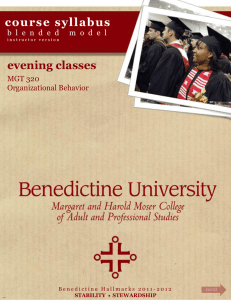
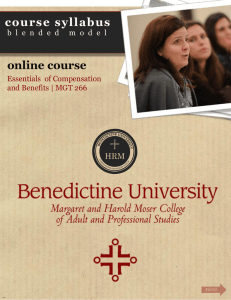
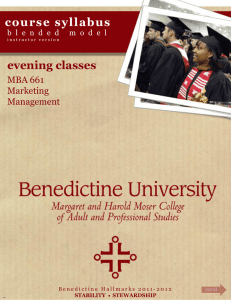
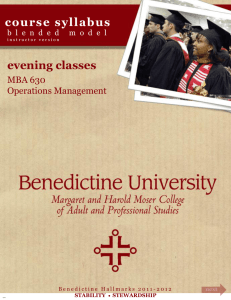
![Time Management [PPT] - University of North Alabama](http://s2.studylib.net/store/data/005233094_1-fdb38f711682ec0557e96ef203e508a9-300x300.png)
